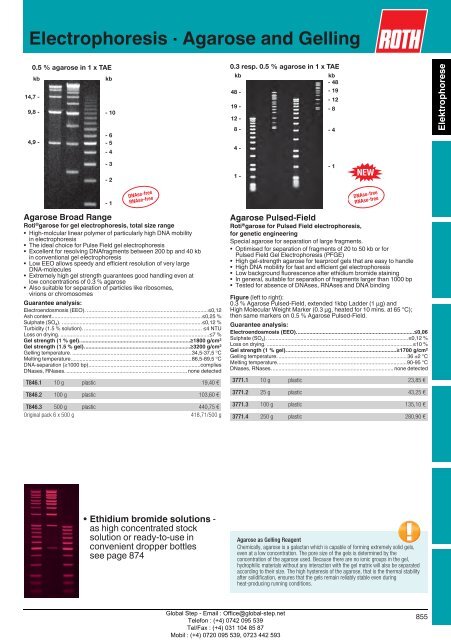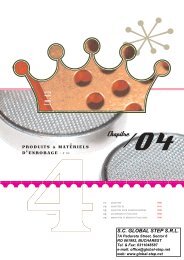Electrophoresis
Electrophoresis
Electrophoresis
Create successful ePaper yourself
Turn your PDF publications into a flip-book with our unique Google optimized e-Paper software.
<strong>Electrophoresis</strong> · Agarose and Gelling<br />
0.5 % agarose in 1 x TAE<br />
kb<br />
14,7 -<br />
9,8 -<br />
4,9 -<br />
kb<br />
- 10<br />
- 6<br />
- 5<br />
- 4<br />
- 3<br />
- 2<br />
- 1<br />
Agarose Broad Range<br />
DNAse-free<br />
RNAse-free<br />
Roti ® garose for gel electrophoresis, total size range<br />
• High-molcular linear polymer of particularly high DNA mobility<br />
in electrophoresis<br />
• The ideal choice for Pulse Field gel electrophoresis<br />
• Excellent for resolving DNAfragments between 200 bp and 40 kb<br />
in conventional gel electrophoresis<br />
• Low EEO allows speedy and efficient resolution of very large<br />
DNA-molecules<br />
• Extremely high gel strength guarantees good handling even at<br />
low concentrations of 0.3 % agarose<br />
• Also suitable for separation of particles like ribosomes,<br />
virions or chromosomes<br />
Guarantee analysis:<br />
Electroendosmosis (EEO). ..................................................................................≤0,12<br />
Ash content......................................................................................................≤0,25 %<br />
Sulphate (SO4 ). ...............................................................................................≤0,12 %<br />
Turbidity (1.5 % solution). ................................................................................ ≤4 NTU<br />
Loss on drying. .....................................................................................................≤7 %<br />
Gel strength (1 % gel)...........................................................................≥1800 g/cm2 Gel strength (1.5 % gel)........................................................................≥3200 g/cm2 Gelling temperature. .................................................................................34,5-37,5 °C<br />
Melting temperature..................................................................................86,5-89,5 °C<br />
DNA-separation (≥1000 bp)............................................................................complies<br />
DNases, RNases. .................................................................................. none detected<br />
T846.1 10 g plastic 19,40 €<br />
T846.2 100 g plastic 103,60 €<br />
T846.3 500 g plastic 440,75 €<br />
Original pack 6 x 500 g 418,71/500 g<br />
• Ethidium bromide solutions -<br />
as high concentrated stock<br />
solution or ready-to-use in<br />
convenient dropper bottles<br />
see page 874<br />
0.3 resp. 0.5 % agarose in 1 x TAE<br />
kb<br />
kb<br />
- 48<br />
48 -<br />
- 19<br />
- 12<br />
19 -<br />
- 8<br />
12 -<br />
8 -<br />
- 4<br />
4 -<br />
1 -<br />
Agarose Pulsed-Field<br />
Global Step - Email : Office@global-step.net<br />
Telefon : (+4) 0742 095 539<br />
Tel/Fax : (+4) 031 104 85 87<br />
Mobil : (+4) 0720 095 539, 0723 442 593<br />
Roti ® garose for Pulsed Field electrophoresis,<br />
for genetic engineering<br />
Special agarose for separation of large fragments.<br />
• Optimised for separation of fragments of 20 to 50 kb or for<br />
Pulsed Field Gel <strong>Electrophoresis</strong> (PFGE)<br />
• High gel-strength agarose for tearproof gels that are easy to handle<br />
• High DNA mobility for fast and efficient gel electrophoresis<br />
• Low background fluorescence after ethidium bromide staining<br />
• In general, suitable for separation of fragments larger than 1000 bp<br />
• Tested for absence of DNAses, RNAses and DNA binding<br />
- 1<br />
DNAse-free<br />
RNAse-free<br />
Figure (left to right):<br />
0.3 % Agarose Pulsed-Field, extended 1kbp Ladder (1 µg) and<br />
High Molecular Weight Marker (0.3 µg, heated for 10 mins. at 65 °C);<br />
then same markers on 0.5 % Agarose Pulsed-Field.<br />
Guarantee analysis:<br />
Electroendosmosis (EEO)................................................................................≤0,06<br />
Sulphate (SO4). ...............................................................................................≤0,12 %<br />
Loss on drying. ...................................................................................................≤10 %<br />
Gel strength (1 % gel)...........................................................................≥1700 g/cm2 Gelling temperature. .......................................................................................36 ±2 °C<br />
Melting temperature........................................................................................90-95 °C<br />
DNases, RNases. .................................................................................. none detected<br />
3771.1 10 g plastic 23,85 €<br />
3771.2 25 g plastic 43,25 €<br />
3771.3 100 g plastic 135,10 €<br />
3771.4 250 g plastic 280,90 €<br />
Agarose as Gelling Reagent<br />
Chemically, agarose is a galactan which is capable of forming extremely solid gels,<br />
even at a low concentration. The pore size of the gels is determined by the<br />
concentration of the agarose used. Because there are no ionic groups in the gel,<br />
hydrophilic materials without any interaction with the gel matrix will also be separated<br />
according to their size. The high hysteresis of the agarose, that is the thermal stability<br />
after solidification, ensures that the gels remain reliably stable even during<br />
heat-producing running conditions.<br />
855<br />
Elektrophorese




